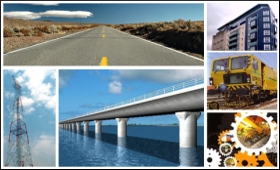|

|
Export credit agencies: Potential partners for Indian infrastructure
|
|

|
|
| Top Stories |
 |
|
|
|
Taponeel Mukherjee | 21 Feb, 2018
Export credit agencies (ECAs) have globally played a significant role in
promoting trade and investments by providing insurance and funding. It
is important for global infrastructure investors and the Indian
government to look at ECAs as a significant enabler of much-needed
infrastructure investments in India.
This is especially true for
new infrastructure projects, or greenfield projects, that need to be
funded. The focus on the role of ECAs needs to encompass that of an
insurance provider, an investor and a liquidity provider in foreign
exchange.
A centralised agency needs to be set up to work with
foreign private investors and ECAs. The focus should be on a few
specific infrastructure sectors to start with. This will help develop a
template for the partnerships to work for all other sectors in the
future.
Once the sectors are identified, the focus must be on
creating contract templates that can be used to create efficient
financing mechanisms. Only once the projects in the pilot sector are
implemented should the mechanism be used to fund new sectors. A
well-drafted financing and contract mechanism will go a long way in
boosting investments in the years to come.
There are a few
fundamental advantages that a robust ECA mechanism can provide that will
boost infrastructure investments. Firstly, a lot of foreign commercial
lenders may not be able to access Indian investments, especially
greenfield, due to the perceived high credit-risk involved. The ECA can
provide insurance to make infrastructure assets in India more
attractive.
Secondly, ECAs, with their credit insurance and
political risk insurance, make debt investments more attractive for
foreign investors. Debt will be the primary source of funding. ECAs,
through their credit-risk mitigating mechanism, greatly assist in
boosting debt investments.
Thirdly, ECAs need to work with
private investors to look at products that help extend the maturity of
the payment stream due from the project or the borrower. This will help
foreign commercial banks with capital to deploy in longer-dated
infrastructure projects. Simply put, a foreign lender looking for
10-year assets, might be able to finance a 15-year asset if ECAs can
design a product that helps in doing so. Being able to extend maturities
will make more infrastructure projects feasible for lenders.
Fourthly,
ECAs can also assist in boosting infrastructure by creating mechanisms
that allow foreign lenders to lend in their home currency. One of the
biggest risks foreign lenders in India face is the foreign exchange
risk. ECAs can create pools of liquidity that allow lenders to hedge the
local currency risk from India.
From a due diligence
perspective, ECAs can act as a second layer of analysis and risk
management, as each ECA will undertake its own independent risk analysis
of projects. Lenders who come through partnerships with such ECAs will
be able to finance projects that are likely to be of higher quality and
better structured.
The ability of the ECA to do additional
analysis and provide the requisite funding mechanism will also encourage
more greenfield risk-taking. A well-structured regulatory mechanism in
partnerships with multiple ECAs has the potential to provide the
required boost to greenfield projects.
The Credit Enhancement
Fund announced in the Budget in 2017 can also get a boost by
collaborating with ECAs from different countries. The Fund is a great
start, but if policymakers can create an environment to encourage ECAs,
it will lead to more efficient capital flow within the ecosystem. The
aim of the Fund is to provide a boost to infrastructure investments by
providing insurance to infrastructure projects. Allowing ECAs from other
countries to operate within India will allow even more infrastructure
investments to be created.
In a country with a large
infrastructure deficit and a banking sector struggling with NPAs,
effective mechanisms to improve the flow of credit is essential. ECAs
provide a significant source of funding and expertise that must be
looked at in greater detail.
(Taponeel Mukherjee heads
Development Tracks, an infrastructure advisory firm. He can be contacted
at taponeel.mukherjee@development-tracks.com or @taponeel on Twitter)
|
|
|
| |
|
|
|
|
|
|
|
|
|
|
|
|
|
|
| |
| Customs Exchange Rates |
| Currency |
Import |
Export |
US Dollar
|
₹91.25
|
₹89.55 |
UK Pound
|
₹122.85
|
₹118.85 |
Euro
|
₹107.95
|
₹104.3 |
| Japanese
Yen |
₹59 |
₹57.1 |
| As on 29 Dec, 2025 |
|
|
| Daily Poll |
 |
 |
| What is your biggest hurdle to scaling right now? |
|
|
|
|
|
| Commented Stories |
 |
|
|
|
|
|
| |
|